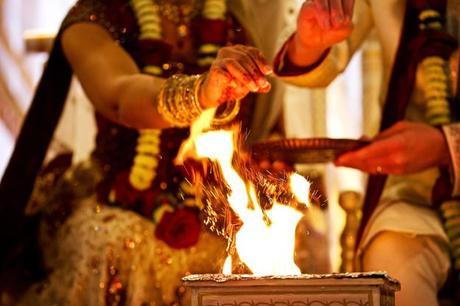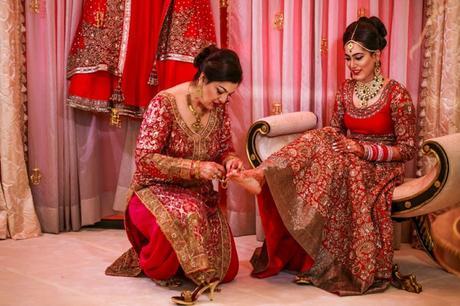Indian weddings are full of age-old customs and traditions that the couple have to go through before they are officially recognized as husband and wife in the eyes of the Hindu community. Each of these traditions and customs holds a deep significance for the couple. Indian weddings are extremely grandiose and colorful, and most marriages often span across three to five days. Some families even opt for week-long celebrations, with lunch or dinner served to guests on each one of those days. Both the bride and the groom are lavishly dressed and henna is applied to the bride’s hands and feet. Gold jewelry can be worn by both the bride and the groom.

Source image
Giving the bride away
Most Indian weddings have key rituals such as the symbolic moment where the father gives away his daughter. If the father is deceased, the bride’s brother or any older male relative will perform this ritual. This particular custom involves the father holding the bride’s hand in his by the holy fire while the priest recites a particular verse from the prayer book. Afterwards, the groom takes the proffered bride’s hand in a symbolic gesture.

Source image
Scared fire
An essential part of Indian wedding ceremonies, the sacred fire is supposed to evoke several Hindu gods and goddesses to bless the ceremony and bear witness to the union. The sacred fire is created from wooden sticks and clarified butter and offerings are often dropped into the fire throughout the ceremony. The bride and groom are often seated side by side in front of the fire.

Source image
The Seven Steps
No Indian wedding is complete without the seven steps. A piece of fabric is tied to the clothes of both the groom and the bride. Then, the couple gets up and walks seven times around the sacred fire as the priest chants seven blessings. Walking around the scared fire is the equivalent of saying the vows in Western Weddings. Each round around the fire symbolizes a particular vow, including being helpful to one another, complementing each other, ensuring the prosperity of each other, making each other happy, creating a harmonious family life, respecting the vows and remaining the best of friends. In some cultures, the bride walks ahead of the groom for the last round around the fire, signifying that she wants to die before her husband.

Source image
Exchanging garlands
Hindu couples often exchange ornate fresh flower garlands during or after the ceremony to welcome each other into their respective families. Exchanging flower garlands often marks their union. This normally precedes the vermillion ceremony whereby the groom applies vermillion too the bride’s forehead and in the parting of her hair, hence bestowing upon her the status of a married woman. In some weddings, the groom also fastens a gold necklace around the bride’s neck, the Indian equivalent of the wedding ring. Other brides choose to go for a toe ring instead. In some cases, the couple also exchanges traditional wedding rings.

